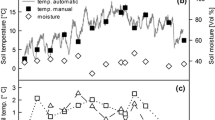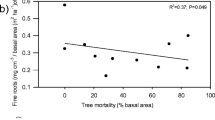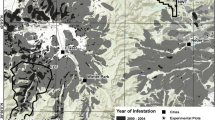Abstract
In central European mountain forests, bark beetle abatement measures implemented after wind and bark beetle disturbances represent a well-defined disturbance regime. We used a biometric approach extended by soil CO2 efflux measurements to study the effects of disturbance-induced stand patchiness on the net ecosystem productivity (NEP) of a mature Norway spruce (Picea abies L. Karst.) forest at the Integrated Monitoring (IM) Long Term Ecological Research (LTER) site “Zöbelboden”, Austria. In the disturbed stand area, roughly 28 % of the spruce trees were salvaged after an initial disturbance and during small-scale bark beetle abatement actions in 2007 and 2008. Aboveground C stocks declined by approximately 33 %, resulting in a 31 and 29 % reduction of biomass NPP and litterfall during the study year 2011. Soil CO2 efflux in the disturbed area (7.5 ± 0.5 t C ha−1 y−1) was significantly lower than in the undisturbed area (9.3 ± 0.6 t C ha−1 y−1). The difference was mainly attributed to the fact that the autotrophic contributions in the disturbed area were lower (22 %) than in the undisturbed area (31 %). Heterotrophic soil respiration was similar in both stand areas (5.9 t C ha−1 y−1 in the disturbed and 6.5 t C ha−1 y−1 in the undisturbed area). Four years after the initial disturbance, the NEP estimated for the undisturbed area was 0.68 and 0.09 t C ha−1 y−1 for the disturbed stand area. Although disturbance and abatement measures substantially lowered the NEP, the C uptake of the remaining trees, along with their dampening effect on soil temperature, ensured that the disturbed forest still served as a weak C sink.



Similar content being viewed by others
References
Amiro BD et al (2010) Ecosystem carbon dioxide fluxes after disturbance in forests of North America. J Geophys Res Biogeosci 115:G00K02. doi:10.1029/2010jg001390
Bartelink HH (1997) Allometric relationships for biomass and leaf area of beech (Fagus sylvatica L). Ann For Sci 54:39–50
Bolte A, Rahmann T, Kuhr M, Pogoda P, Murach D, Gadow K (2004) Relationships between tree dimension and coarse root biomass in mixed stands of European beech (Fagus sylvatica, L.) and Norway spruce (Picea abies [L.] Karst.). Plant Soil 264:1–11. doi:10.1023/B:PLSO.0000047777.23344.a3
Bonan GB (2008) Forests and climate change: forcings, feedbacks, and the climate benefits of forests. Science 320:1444–1449
Brown M et al (2010) Impact of mountain pine beetle on the net ecosystem production of lodgepole pine stands in British Columbia. Agric For Meteorol 150:254–264. doi:10.1016/j.agrformet.2009.11.008
Chambers JQ, Fisher JI, Zeng H, Chapman EL, Baker DB, Hurtt GC (2007) Hurricane Katrina’s carbon footprint on U.S. Gulf Coast forests. Science 318:1107. doi:10.1126/science.1148913
Dale VH et al (2001) Climate change and forest disturbances. BioScience 51:723–734. doi:10.1641/0006-3568(2001)051[0723:ccafd]2.0.co;2
De Wit HA, Palosuo T, Hylen G, Liski J (2006) A carbon budget of forest biomass and soils in southeast Norway calculated using a widely applicable method. For Ecol Manag 225:15–26. doi:10.1016/j.foreco.2005.12.023
Eckmüllner O (2006) Allometric relations to estimate needle and branch mass of Norway spruce and Scots pine in Austria. Cent Gesamte Forstwes 123:7–16
Edburg SL, Hicke JA, Lawrence DM, Thornton PE (2011) Simulating coupled carbon and nitrogen dynamics following mountain pine beetle outbreaks in the western United States. J Geophys Res Biogeosci 116:G04033. doi:10.1029/2011jg001786
Edburg SL et al (2012) Cascading impacts of bark beetle-caused tree mortality on coupled biogeophysical and biogeochemical processes. Front Ecol Environ 10:416–424. doi:10.1890/110173
Gardiner B et al (2010) Destructive storms in European forests: past and forthcoming impacts. In: Final Report to the European Commission—DG Environment. European Forest Institute—Atlantic European Regional Office, p 138
Hanson PJ, Edwards NT, Garten CT, Andrews JA (2000) Separating root and soil microbial contributions to soil respiration: a review of methods and observations. Biogeochemistry 48:115–146
Harmon ME, Bond-Lamberty B, Tang J, Vargas R (2011) Heterotrophic respiration in disturbed forests: a review with examples from North America. J Geophys Res Biogeosci 116:G00K04. doi:10.1029/2010jg001495
Hicke JA et al (2012) Effects of biotic disturbances on forest carbon cycling in the United States and Canada. Glob Change Biol 18:7–34. doi:10.1111/j.1365-2486.2011.02543.x
Janssens IA et al (2003) Europe’s terrestrial biosphere absorbs 7 to 12% of European anthropogenic CO2 emissions. Science 300:1538–1542
Knohl A, Kolle O, Minayeva TY, Milyukova IM, Vygodskaya NN, Foken T, Schulze ED (2002) Carbon dioxide exchange of a Russian boreal forest after disturbance by wind throw. Glob Change Biol 8:231–246
Körner C (2003) Slow in, rapid out—carbon flux studies and Kyoto targets. Science 300:1242–1243. doi:10.1126/science.1084460
Köster K, Püttsepp Ü, Pumpanen J (2011) Comparison of soil CO2 flux between uncleared and cleared windthrow areas in Estonia and Latvia. For Ecol Manag 262:65–70. doi:10.1016/j.foreco.2010.09.023
Kurz WA et al (2008) Mountain pine beetle and forest carbon feedback to climate change. Nature 452:987–990
Ledermann T, Neumann M (2006) Biomass equations from data of old long-term experimental plots. Cent Gesamte Forstwes 123:47–64
Luyssaert S et al (2008) Old-growth forests as global carbon sinks. Nature 455:213–215
Mathys A et al (2013) Carbon balance of a partially harvested mixed conifer forest following mountain pine beetle attack and its comparison to a clear-cut. Biogeosciences 10:5451–5463. doi:10.5194/bg-10-5451-2013
Mayer M, Matthews B, Schindlbacher A, Katzensteiner K (2014) Soil CO2 efflux from mountainous windthrow areas: dynamics over 12 years post-disturbance. Biogeosciences 11:6081–6093. doi:10.5194/bg-11-6081-2014
Moore DJP et al (2013) Persistent reduced ecosystem respiration after insect disturbance in high elevation forests. Ecol Lett 16:731–737. doi:10.1111/ele.12097
Morehouse K, Johns T, Kaye J, Kaye M (2008) Carbon and nitrogen cycling immediately following bark beetle outbreaks in southwestern ponderosa pine forests. For Ecol Manag 255:2698–2708. doi:10.1016/j.foreco.2008.01.050
Muscolo A, Sidari M, Bagnato S, Mallamaci C, Mercurio R (2010) Gap size effects on above- and below-ground processes in a silver fir stand. Eur J For Res 129:355–365. doi:10.1007/s10342-009-0341-z
Nave LE, Vance ED, Swanston CW, Curtis PS (2010) Harvest impacts on soil carbon storage in temperate forests. For Ecol Manag 259:857–866. doi:10.1016/j.foreco.2009.12.009
Nunn AJ, Weiser G, Reiter IM, Häberle K-H, Grote Rd, Havranek WM, Matyssek R (2006) Testing the unifying theory of ozone sensitivity with mature trees of Fagus sylvatica and Picea abies. Tree Physiol 26:1391–1403
Ostonen I, Lõhmus K, Pajuste K (2005) Fine root biomass, production and its proportion of NPP in a fertile middle-aged Norway spruce forest: comparison of soil core and ingrowth core methods. For Ecol Manag 212:264–277. doi:10.1016/j.foreco.2005.03.064
Pajtík J, Konôpka B, Lukac M (2011) Individual biomass factors for beech, oak and pine in Slovakia: a comparative study in young naturally regenerated stands. Trees 25:277–288. doi:10.1007/s00468-010-0504-z
Perruchoud D, Kienast F, Kaufmann E, Bräker OU (1999) 20th century carbon budget of forest soils in the Alps. Ecosystems 2:320–337. doi:10.1007/s100219900083
Pollanschütz J (1974) Formzahlfunktionen der Hauptbaumarten Österreichs. Informationsdienst Forstliche Bundesversuchsanstalt Wien 153:341–343
Pregitzer KS, Euskirchen ES (2004) Carbon cycling and storage in world forests: biome patterns related to forest age. Glob Change Biol 10:2052–2077
Ritter E, Dalsgaard L, Einhorn KS (2005) Light, temperature and soil moisture regimes following gap formation in a semi-natural beech-dominated forest in Denmark. For Ecol Manag 206:15–33. doi:10.1016/j.foreco.2004.08.011
Schelhaas MJ, Nabuurs GJ, Schuck A (2003) Natural disturbances in the European forests in the 19th and 20th centuries. Glob Change Biol 9:1620–1633
Schindlbacher A, Zechmeister-Boltenstern S, Glatzel G, Jandl R (2007) Winter soil respiration from an Austrian mountain forest. Agric For Meteorol 146:205–215
Schindlbacher A, Zechmeister-Boltenstern S, Jandl R (2009) Carbon losses due to soil warming: do autotrophic and heterotrophic soil respiration respond equally? Glob Change Biol 15:901–913
Seidl R, Schelhaas M-J, Lexer MJ (2011) Unraveling the drivers of intensifying forest disturbance regimes in Europe. Glob Change Biol 17:2842–2852. doi:10.1111/j.1365-2486.2011.02452.x
Seidl R, Schelhaas M-J, Rammer W, Verkerk PJ (2014) Increasing forest disturbances in Europe and their impact on carbon storage. Nature Clim Change 4:806–810. doi:10.1038/nclimate2318 http://www.nature.com/nclimate/journal/vaop/ncurrent/abs/nclimate2318.html#supplementary-information
Williams CA, Vanderhoof MK, Khomik M, Ghimire B (2014) Post-clearcut dynamics of carbon, water and energy exchanges in a midlatitude temperate, deciduous broadleaf forest environment. Glob Change Biol 20:992–1007. doi:10.1111/gcb.12388
WRB IWG (2006) World reference base for soil resources 2006, vol 2nd edition. World Soil Resources Reports No. 103, FAO Rome
Zerva A, Mencuccini M (2005) Carbon stock changes in a peaty gley soil profile after afforestation with Sitka spruce (Picea sitchensis). Ann For Sci 62:873–880
Zianis D, Muukkonen P, Mäkipää R, Mencuccini M (2005) Biomass and stem volume equations for tree species in Europe. Silva Fennica Monographs 4:1–63
Acknowledgments
The work was co-funded by the project “CO2 emissions from mountain forest soils after disturbance” (No. 100513) of The Austrian Federal Ministry of Agriculture, Forestry, Environment and Water Management and was carried out within the framework of the International Cooperation Program (ICP) Integrated Monitoring as part of the UN-ECE Convention on Long-Range Transboundary Air Pollution (CLRTAP). We are extremely grateful for the manifold support from the “National Park Kalkalpen” and Austrian Federal Forests (ÖBF).
Author information
Authors and Affiliations
Corresponding author
Additional information
Communicated by Christian Ammer.
Rights and permissions
About this article
Cite this article
Kobler, J., Jandl, R., Dirnböck, T. et al. Effects of stand patchiness due to windthrow and bark beetle abatement measures on soil CO2 efflux and net ecosystem productivity of a managed temperate mountain forest. Eur J Forest Res 134, 683–692 (2015). https://doi.org/10.1007/s10342-015-0882-2
Received:
Revised:
Accepted:
Published:
Issue Date:
DOI: https://doi.org/10.1007/s10342-015-0882-2




